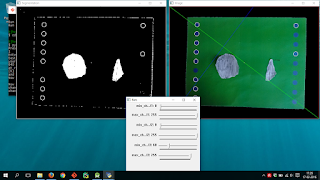How to use OpenCV on an Android Activity
I created a new Activity on the Android project called TestActivity to make the debugging easier. It uses a picture that was already taken and stored in memory. To make an Activity work with OpenCV you can follow this tutorialhttp://docs.opencv.org/2.4/doc/tutorials/introduction/android_binary_package/dev_with_OCV_on_Android.html.
In my case I added a LoaderCallback attribute to the TestActivity class:
private BaseLoaderCallback mLoaderCallback =
new BaseLoaderCallback(this) {
@Override
public void onManagerConnected(int status) {
switch (status) {
case LoaderCallbackInterface.SUCCESS: {
Log.d(TAG, "OpenCV loaded");
}
break;
default: {
super.onManagerConnected(status);
}
break;
}
}
};
And this lines inside the onCreate() method:
// --------------------------------------------------------------------------
// OpenCVLoader
if (!OpenCVLoader.initDebug()) {
mLoaderCallback.
onManagerConnected(LoaderCallbackInterface.INIT_FAILED);
} else {
mLoaderCallback.
onManagerConnected(LoaderCallbackInterface.SUCCESS);
}// ---------------------------------------------------------------------------
Loading an OpenCV SVM on Android
To use the SVM previously computed with Python it was necessary to do something triky. The SVM class has a function load(filename). The problem is that in Android filenames are not as easy as in a PC. You may have the file stored in external or internal memory, on the local folder of the app or in the res/raw/ directory of the source code. So I followed a sample from OpenCV Android, a project called face-detection. They store the model file in a /res/raw/ directory inside the source code and what they do is to open it and make a local copy of it. So when the load method is called it uses the local copy.
InputStream is = getResources().openRawResource(R.raw.lbpcascade_frontalface);
File cascadeDir = getDir("cascade", Context.MODE_PRIVATE);
mCascadeFile = new File(cascadeDir, "lbpcascade_frontalface.xml");
FileOutputStream os = new FileOutputStream(mCascadeFile);
byte[] buffer = new byte[4096];
int bytesRead;
while ((bytesRead = is.read(buffer)) != -1) {
os.write(buffer, 0, bytesRead);
}
is.close();
os.close();
mJavaDetector = new CascadeClassifier(mCascadeFile.getAbsolutePath());
The method getAbsolutePath( ) is what you need as filename. After using that I was able to load the SVM and use it to predict the class of the image.







